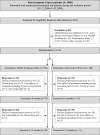Efficacy of multimodal exercise-based rehabilitation on physical activity, cardiorespiratory fitness, and patient-reported outcomes in cancer survivors: a randomized, controlled trial
- PMID: 23704198
- PMCID: PMC3755327
- DOI: 10.1093/annonc/mdt185
Efficacy of multimodal exercise-based rehabilitation on physical activity, cardiorespiratory fitness, and patient-reported outcomes in cancer survivors: a randomized, controlled trial
Abstract
Background: Sedentary behavior and impaired cardiovascular reserve capacity are common late effects of cancer therapy emphasizing the need for effective strategies to increase physical activity (PA) in cancer survivors. We examined the efficacy of a 12-month exercise-based rehabilitation program on self-reported PA, cardiorespiratory fitness (VO2peak), strength, and patient-reported outcomes.
Patients and methods: Two hundred fourteen post-treatment cancer survivors were randomly assigned to a 12-month rehabilitation program consisting of individual (x3) and group-based (x6) counseling in combination with once weekly high-intensity group-based exercise training (the Copenhagen Physical Activity after Cancer Treatment, PACT; n = 108) or to a health evaluation program (HE, n = 106). Study outcomes were assessed at baseline, 6 months, and 12 months.
Results: After 12 months, the percentage of patients reporting meeting PA goal behavior (≥3 h/week) was significantly increased in the PACT group versus the HE group (70.4% versus 43.4%, P = 0.001). Repeated measures analyses indicated a statistically significant improvement in VO2peak (l min(-1)) in favour of PACT (treatment effect ratio = 1.04; 95% confidence interval 1.00-1.07; P = 0.032). Significant between group differences were also observed for strength (P < 0.001), depression (P = 0.020) and mental health (P = 0.040).
Conclusion: A 12-month exercise-based rehabilitation program is an effective strategy to promote PA and improve VO2peak in cancer survivors.
Keywords: cancer survivors; cardiorespiratory fitness; exercise; physical activity behavior; rct; rehabilitation.
Figures
Comment in
-
Striving to improve patient-reported outcomes for cancer survivors as the war wages on.Ann Oncol. 2013 Sep;24(9):2204-5. doi: 10.1093/annonc/mdt261. Epub 2013 Jul 17. Ann Oncol. 2013. PMID: 23868904 No abstract available.
References
-
- American Cancer Society. Cancer Facts & Figures 2012 [Online publication] Atlanta: American Cancer Society; 2012. http://www.cancer.org/acs/groups/content/@epidemiologysurveilance/docume... (14 May 2013, date last accessed).
-
- Lakoski SG, Eves ND, Douglas PS, et al. Exercise rehabilitation in patients with cancer. Nat Rev Clin Oncol. 2012;9:288–296. doi:10.1038/nrclinonc.2012.27. - DOI - PMC - PubMed
-
- Speck RM, Courneya KS, Masse LC, et al. An update of controlled physical activity trials in cancer survivors: a systematic review and meta-analysis. J Cancer Surviv. 2010;4:87–100. doi:10.1007/s11764-009-0110-5. - DOI - PubMed
-
- Fong DY, Ho JW, Hui BP, et al. Physical activity for cancer survivors: meta-analysis of randomised controlled trials. BMJ. 2012;344:e70. doi:10.1136/bmj.e70. - DOI - PMC - PubMed
-
- Wisloff U, Ellingsen O, Kemi OJ. High-intensity interval training to maximize cardiac benefits of exercise training? Exerc Sport Sci Rev. 2009;37:139–146. doi:10.1097/JES.0b013e3181aa65fc. - DOI - PubMed
Publication types
MeSH terms
Grants and funding
LinkOut - more resources
Full Text Sources
Other Literature Sources
Medical
Miscellaneous


